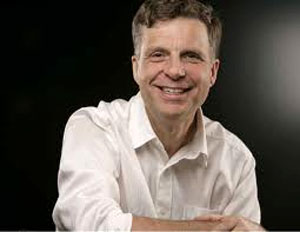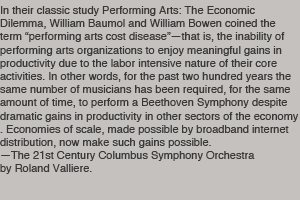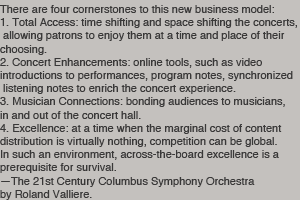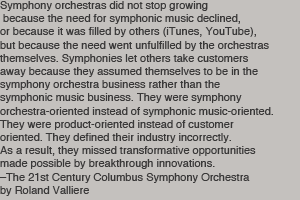Tony Woodcock, President of the New England Conservatory, recently posted an interview with Columbus Symphony President Roland Valliere on
his blog. As a member of the Columbus Symphony Orchestra Committee I have had the pleasure of working closely with Roland and I'm glad to see him being recognized in this manner. Considering the dire financial condition of the Columbus Symphony over the past few years, it's amazing that we still have an orchestra, and Roland deserves a lot of credit for that. Here is Tony Woodcock's
conversation with Roland Valliere:
Outsourcing Orchestra Administration: The Columbus Symphony Turns Crisis into Opportunity

Roland Valliere
When Roland Valliere took over the Columbus Symphony in August 2009, the orchestra was on the brink of collapse. There had been a bitter work stoppage the previous year. The budget was unsustainable even after shortening the season and reducing the administrative staff. There was no capitalization. The endowment had been spent to cover operating deficits. There was no line of credit, no cash reserves, no unrestricted endowment. And both the Music Director and Executive Director had left. Roland, who is all about reinvention and had masterminded a promising new high tech device that he believed would revolutionize the concert experience, felt there was an opportunity to turn things around by creating a new business model. I talked to him—he is now the President and Chief Creative Officer– about the solutions he has put in place and how the orchestra is faring almost two years later.
Tony: Just before you went to Columbus, you had switched gears, left your previous job as Executive Director of the Kansas City Symphony to become an entrepreneur. The project you were working on is a fascinating example of your creativity. Tell me about that.
It’s a handheld device that offers explanatory text, program notes and video images in real time with the music. It’s analogous to the audio guides you can rent in a museum. The audio guides offer an aural enhancement of a visual experience. CoCo offered a textual enhancement of an aural experience. With funding from the Mellon, Knight, and Hewlett and Packard Foundations, we were able to do three rounds of testing over about five years. Then, we began a startup with the Juilliard School to produce some educational products under the Juilliard name called “Juilliard Discoveries.” That was my path in the Fall of 2008 when the economy tanked. We were about to launch the second round of funding for the Juilliard startup and, unfortunately, our lead funder was invested with Bernie Madoff! The project went sideways because of that. It was just at this moment that the Columbus Symphony called. 
Columbus Symphony
Tony: The situation there was pretty dire, wasn’t it?
Roland: Well, the orchestra had a checkered history financially but a stellar artistic reputation. In 2007-08, there had been a lot of public hand-to-hand combat with a messy work stoppage. Before the work stoppage, the orchestra had been on a trajectory of moving toward a 52-week contract and a budget of $12.5 million. But that budget couldn’t be funded. When I came in, the budget had been reduced to $9 million, which was viewed as sustainable. To get to that figure, they had reduced the season from 46 weeks to 38 weeks and the staff from 28 fulltime and 10 part-time to 18 fulltime and 4 part-time. At that time, there were 53 fulltime contracted musicians.
Tony: But, in fact, even those austerity measures weren’t enough, were they?
Roland: No. But, as you know, the Chinese character for “crisis” is made up of two characters that mean danger and opportunity. I felt there was opportunity in the situation so long as the organization was not hemorrhaging so badly that it couldn’t be revived. I felt it could be revived and saw a chance to do something new.
Tony: Before you committed, you did something that was essential to your strategy.
Roland: Yes, this was a critical thing. I met with the head of the union and the orchestra committee and talked about some of the ideas I had. I told them I would need to work with them in close collaboration as partners—even though that had not always been the case there. And I wanted some assurance from them that this was their goal as well. If the communications were transparent, open and honest—and I assured them they would be from my perspective, then we would have a chance to move in a new direction. They were very supportive of that. The position would not have been attractive to me otherwise.
Tony: So, even the $9 million budget couldn’t be balanced?
Roland: That’s correct. This was true for a variety of reasons. We needed time to ramp up, we had lost momentum with subscription renewals, we had lost credibility with the public, and this had impacted the Annual Fund. When I put together a budget and added up the annualized revenue from ticket sales, fees and contributions, I realized that the budget, really to be sustainable, was only $7.5 million—about $1.5 million from where we were. So I put together a White Paper, The 21st Century Columbus Symphony, with the view forward, a new vision, and a different future, plus the corresponding need to fund that vision to the tune of $1.5 million which we called a Transition Fund. We had success in raising that. But at the same time the Annual Fund, mainly due to the economy, was proving even more challenging then we thought. It went off the rails in January 2010. We didn’t meet our December goals and since we didn’t have a safety net, we found ourselves in a potentially devastating situation. This was no surprise to the board and musicians because I had projected that we would run out of funds in March if we didn’t raise the funding in advance of that. When fundraising ran short in December, it became evident we would have a severe problem and not be able to make payroll in February.
 Tony: At which point, you turned to the board and musicians with four options?
Tony: At which point, you turned to the board and musicians with four options?Roland: Yes. The options went from bad to worse, including reducing the number of full time players (from 53 to 21), moving to a freelance orchestra (with no benefits or guaranteed services) or folding the tent completely. Ultimately we agreed to further reduce the season (from 36 to 25 weeks) and consolidate the administration with the Columbus Association for the Performing Arts (CAPA). This was very difficult, especially for the musicians, and remarkably was achieved in a spirit of collaboration.
Tony: So talk about the administrative reorganization.

William B. Connor
We discussed an administrative consolidation or merger, a process that took a month to figure out.
Tony: Explain what CAPA is, would you?
Roland: CAPA began in 1969 by saving from the wrecking ball the historic Ohio Theatre in Columbus, renovating that venue, and then operating it along with several other theatres it acquired/or managed in Columbus, New Haven, CT and other places. It provides shared services to a number of arts organizations including ticketing, marketing, public relations, finance, human resources, IT, and development/fundraising. What it offers each group is custom tailored to the group’s individual needs.
Tony: Describe the Columbus Symphony’s organizational arrangement with CAPA.
Roland: It functions much like a holding company. The Columbus Symphony’s board continues as before, with its own committees, fundraising work, Executive Committee, but the CAPA board has ultimate fiduciary responsibility. There is a kind of cross-fertilization on the two boards, with two of our board members, including our chairman Martin Inglis, sitting on the CAPA board. Bill Conner wears two hats as President and CEO of CAPA and as Managing Director and CEO of the Columbus Symphony. He has management responsibility on a daily basis for the symphony.
Tony: Your position evolved into something that’s probably unique in symphony management, isn’t it?
Roland: Yes. A ship can have only one captain and we agreed that that should be Bill. The board and musician leadership asked me to stick around to see the transition through and help set a future course. The CAPA arrangement went into effect in April 2010 and at that point I acquired a new title, that of President and Chief Creative Officer. I don’t think there’s another position like it in the industry.
My portfolio originally consisted of four key areas:
1. to abet the integration with CAPA
2. to facilitate the conclusion of our search for a new music director—which we did and hired Jean-Marie Zeitouni, who is a terrific catch.

Jean-Marie Zeitouni
3. to lead the collective bargaining talks with the musicians’ union and negotiate a new contract before the expiration of the current agreement in August 2011. We did this last March and produced a new four year agreement. I thought it would be a six month process, but we concluded it in a week—a reflection of our resolve to work together, even in tough times, for the greater good of the organization.
4. to create the “21st Century Columbus Symphony,” that is, to figure out the business model for going forward and guide this with CAPA and the Board. This is what I’m most focused on today.
 Tony: How does your position dovetail with Bill Conner’s?
Tony: How does your position dovetail with Bill Conner’s?Roland: We’re joined at the hip, with Bill focused largely on the day-to-day running of the organization and me focused on strategy and innovation. Both Bill and I, along the our Music Director Jean-Marie Zeitouni, report directly to the board through the chairman of the board.
Tony: You are now about 1 1/2 years into the arrangement with CAPA. How is it working out?
Roland: In the first full year of implementation, operating on a $7 million budget, we were able to eke out a small surplus. I had expected we would realize a savings of about $500,000 from the integration with CAPA, but in fact we were able to do better than that. There was an upside in revenue, which we hadn’t anticipated. Both the City and the County stepped up to a major degree in way they never had before, each making multi-year $250,000 commitments. A number of corporations stood up too.
We have a five-year agreement with CAPA and our goals are threefold:
1. stabilize the finances by balancing the budget, which we did last year and are on track to do this year
2. establish a cash reserve so we could have an operating fund. Part of deal with CAPA was that they provide us with a line of credit. That was a blood infusion that we desperately needed.
3. build up the endowment to $20 million or more to generate revenue for the operating budget.
 Tony: So, let’s talk about your vision for the 21st Century Columbus Symphony.
Tony: So, let’s talk about your vision for the 21st Century Columbus Symphony.Roland: Well, there are several themes. Education is key. We’re coming to see that music and the arts can be windows for developing creative and innovative thinking, the ability to problem solve. How can the Columbus Symphony make a contribution to that? How can we make ourselves more accessible—perhaps in part by making our content available in a time- and space-shifted manner. We need to stop focusing on the traditional model and figure out how we can serve our community in our unique way. We need to find a way for the orchestra to do R&D, something that takes money and the freedom to fail.
Over the next one to three years, we’re looking at several things:
1. Maintaining a budget that matches supply with demand
2. Diversifying our concert locations so that next year instead of doing all 12 subscription concerts in the Ohio Theatre, which is too large, we will do eight there and four at the smaller Southern Theatre, fitting our repertoire to the theatre.
3. Experimenting with new concert formats such as one-hour Rush Hour concerts and one-hour Noon Concerts.
4. Utilizing the Internet and social media as marketing and education tools and offering more streaming or video opportunities. We’ve discussed creating total access subscriptions, whereby premium subscribers would have access to the concerts both physically and virtually in a time- and space-shifted fashion.
At the end of the day, the Columbus Symphony exists to serve our community through the wonder of great music. It’s about connecting the music to people.
In a world of lightning fast change, we need to embrace the opportunity that such change provides and muster the courage and resources required to take smart and calculated risks.














